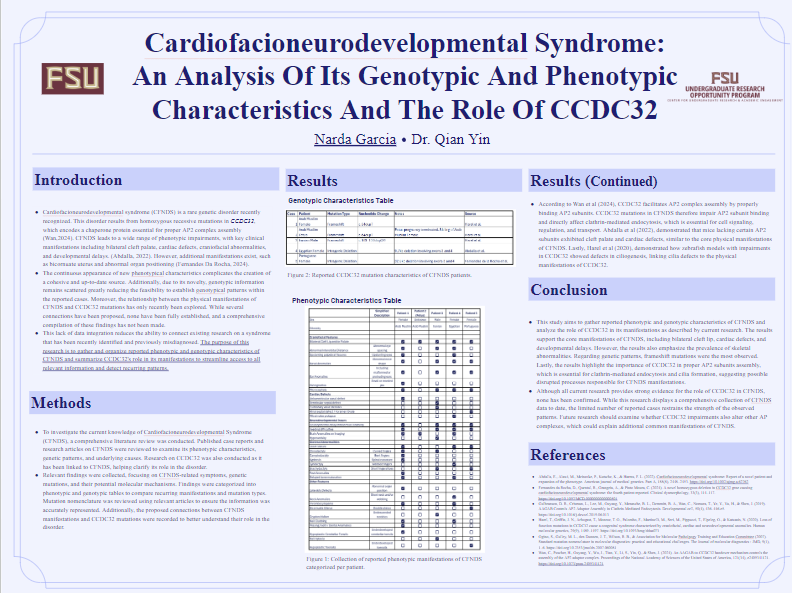Research Symposium
25th annual Undergraduate Research Symposium, April 1, 2025
Narda Garcia Poster Session 3: 1:45 pm - 2:45 pm/ Poster #214

BIO
I am a sophomore majoring in cellular and molecular neuroscience. I'm from Miami and plan to attend medical school after graduation. My goal is to become a well-rounded physician with a strong background in research.
Cardiofacioneurodevelopmental Syndrome: An Analysis Of Its Genotypic And Phenotypic Characteristics And The Role Of CCDC32
Authors: Narda Garcia, Dr. Qian YinStudent Major: Cell and Molecular Neuroscience
Mentor: Dr. Qian Yin
Mentor's Department: Biological Science Mentor's College: College of Arts and Sciences Co-Presenters:
Abstract
Cardiofacioneurodevelopmental syndrome (CFNDS) is a rare genetic disorder linked to homozygous recessive mutations in CCDC32, a chaperone protein essential for the AP2 complex assembly. Impairment of the AP2 adaptor complex disrupts critical processes for cellular function. However, the clear relationship between CCDC32 mutations and the diverse phenotypic manifestations of CFNDS remains unclear. This research aims to compile reported phenotypic and genotypic characteristics of CFNDS while summarizing the role of CCDC32 in its physical manifestations to improve accessibility to available information and distinguish recurring patterns. A targeted literature review was conducted to gather phenotypic characteristics, genetic patterns, and the connection between CFNDS and CCDC32 by examining peer-reviewed medical reports and research articles. Data from all reported cases were gathered and organized into phenotypic and genotypic tables for better comprehension. The most common clinical features noted in individuals with CFNDS were craniofacial abnormalities, cardiac defects, and neurodevelopmental delays, often related to the frameshift mutation observed in three out of the five cases. Additionally, multiple studies have linked CFNDS manifestations to CCDC32 impairments, which compromise AP2 complex assembly and lead to disruptions in clathrin-mediated endocytosis and cilia formation. These disruptions affect multiple cellular mechanisms and body systems, explaining the various phenotypic expressions of CFNDS. These findings highlight the critical role of CCDC32 in cellular activities and its clear association to CFNDS’s phenotypic characteristics. Further research should focus on investigating the relationship between CCDC32 and different AP complexes to determine whether impairments in their assembly have a role in further CFNDS manifestations.
Keywords: Cardiofacioneurodevelopmental syndrome, CFNDS, CCDC32


